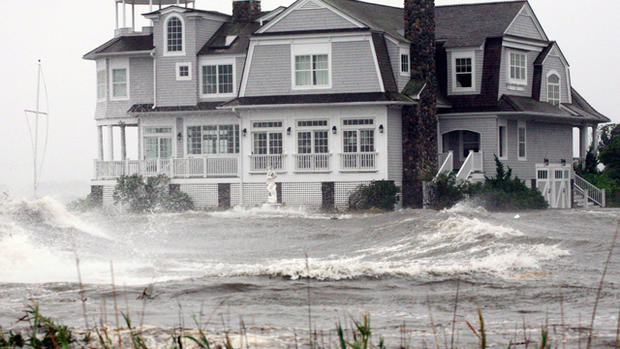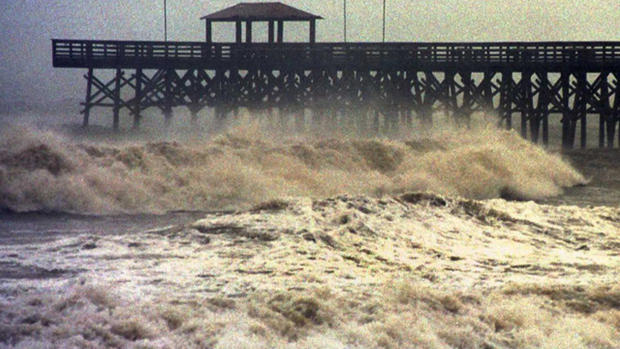States try to gauge damage in Irene's wake
RALEIGH, N.C. - Hurricane Irene fell short of the doomsday predictions of record-breaking storm surges in North Carolina and Virginia when it lumbered ashore. But a slow-crawling storm that spread out hundreds of miles was still hurling heavy rain and high winds at a wide swath of the East Coast a day after its first U.S. landfall, vexing officials attempting to gauge the full damage toll on the region.
Already it was clear Irene's storm surge had triggered scattered flooding in coastal areas, plunged more than 2 million power customers into darkness and roughed up one of the most densely populated areas of the country. Inititial reports suggested light damages in many areas from Irene, a lower-strength hurricane when it first barreled ashore in the U.S. on Saturday. But Irene inflicted scattered damage over an area so broad that the totality of the damage or the costs involved were not yet known.
Authorities said teams would be deploying Sunday in a bid to assess the full extent and severity of those damages after the passing of the storm, which is blamed for the loss of at least eight lives.
Hurricane Irene tracker
Complete Coverage: Hurricane Irene
Virginia's Gov. Bob McDonnell had initially warned that Irene one of those rare hurricanes that virtually takes aim at the entire East Coast could be a "catastrophic" monster with record storm surges of up to 8 feet in some coastal areas of his state.
National Weather Service meteorologist Mike Montefusco said Norfolk came closest, with a storm surge of 7.55 feet. Six to 8 inches of rainfall fell over the region, and more was expected as Irene slowly left Virginia for the Northeast.
"I think it's a little strong to say we dodged a bullet, however it certainly could have turned out worse," Montefusco said.
Emergency crews around the region got set to head out after daybreak to assess damage reports like the one confirmed tornado in Chincoteague, Va. There was at least one other suspected tornado that ripped away roofs in another Virginia community, Sandbridge.
Authorities say Irene also blocked roads as it knocked out power in several areas of Virginia.
In North Carolina, authorities reported storm surge flooding along some waterways, impassible roads and up to a foot of rain in some areas.
Infrastructure was a chief worry in the region, where the sprawl of major cities, suburban communities and beachfront properties had set many civil defense planners on edge as Irene approached the region. Ports, airports, nuclear power plants and more lay in the path of such a widespread storm, its storm bands spreading out about 500 miles at one point.
In Lusby, Md., Constellation Energy Nuclear Group said one of two nuclear reactors at Calvert Cliffs went off-line automatically because of Irene's winds. Constellation said the plant is safe and stable.
Mark Sullivan, a spokesman for Constellation, issued a statement early Sunday saying it appears the Unit 1 reactor went off-line automatically when a large piece of aluminum siding dislodged from a building and came into contact with a transformer late Saturday night. He added all employees were safe, though an "unusual event" was declared the lowest of four emergency classifications by the Nuclear Regulatory Commission. The Unit 2 reactor in the complex wasn't affected and kept up operation, he said.
North Carolina Gov. Beverly Perdue said Irene inflicted significant damage along the North Carolina coast, adding that some areas were unreachable because of high water or downed power lines. Perdue planned an air tour Sunday of the hardest-hit coastal counties after TV coverage showed downed trees, toppled utility poles and power lines and mangled awnings. As with other states along the East Coast, there was no preliminary estimate yet of the dollar amount of damages.
Officials in North Carolina's Dare County said they were advised there was extensive flooding. A county emergency official, Dorothy Toolan, said teams would have to check the reports firsthand.
Elsewhere, authorities suggested Irene didn't create the kind of havoc that had been anticipated.
Bruce Shell, New Hanover County manager, said assessment teams were already in the streets on Saturday after the storm passed to make their evaluations, but they found nothing to raise alarm. Irene passed close to the county's coastline, but didn't make landfall there.
"We were prepared for a lot worse, but we got lucky on this one," Shell said.
Shell said he couldn't find any evidence of serious damage.
He said many of the 70,000 homes which lost power were back online by the end of the evening. Emergency operations for the county and for the city of Wilmington were shut down by 6 p.m. Shell said there was apparently a wastewater spill at Wrightsville Beach, but it appeared to be minor.
Pinehurst dentist Harwell Palmer, 53, said the worst that happened to his home at Ocean Isle Beach was a few pieces of siding that he was able to replace after riding out the storm. He said there was some street flooding, and high waves pounded the local pier, but it was still standing. Ocean Isle Beach missed a direct hit from Irene.
What did concern Palmer was the beach itself after heavy surf gobbled up shoreline.
"The main concern we will have going forward is the loss of beach," Palmer said.
The question still facing the region was whether Irene's impact would match the problems left behind by previous storms Floyd and Isabel.
In 1999, Floyd dropped at least 15 inches of rain on the eastern third of North Carolina. The flooding was the most damaging in the state's history, topping $3 billion in North Carolina alone after buildings were submerged, roads flooded, and livestock drowned.
Four years later, Isabel brought hurricane conditions to eastern North Carolina and southeast Virginia, causing about $1 billion in damages.


